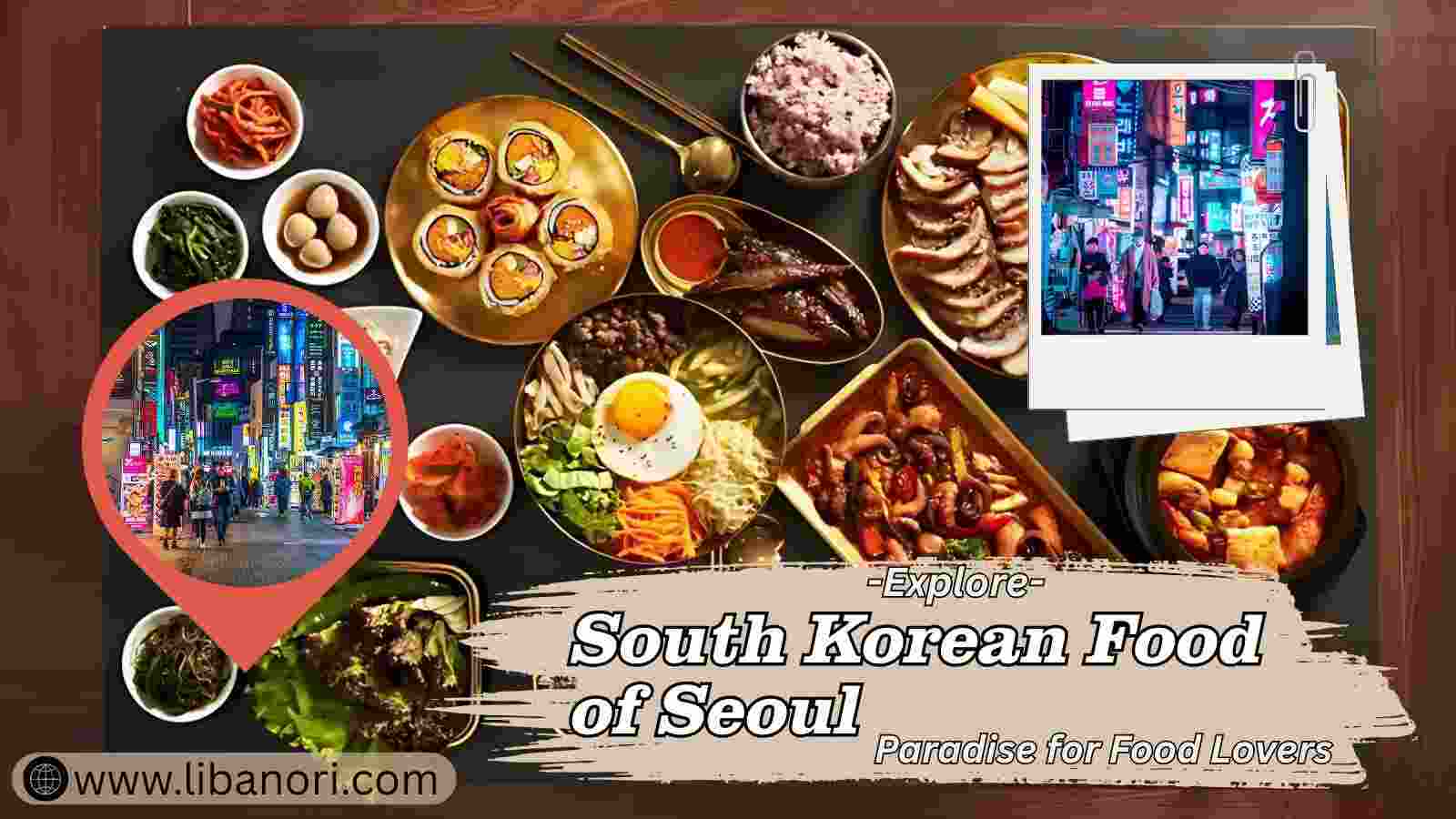Korean cuisine offers a rich blend of bold and subtle flavors—spicy, sweet, and deeply savory—that reflect the richness and vibrancy of Korea’s cultural history. Visiting South Korea’s capital, Seoul, is like stepping into a Food Lover’s paradise. Whether you’re sampling street snacks, traditional royal meals, or comforting home-cooked dishes, Seoul’s culinary scene offers something for everyone.
In this blog, we’ll explore the most popular South Korean food, highlighting must-try dishes in Seoul, and share insider tips on where to find the best eats in the city.
What Makes South Korean Food So Tasty?
Korean food is all about balance—flavors, nutrition, color, and even temperature. Meals often include rice, meats, vegetables, fermented foods (especially the must-try kimchi), and banchan (side dishes). The culture of communal eating turns every meal into a shared, social experience—much more than just satisfying hunger.
Key Ingredients and Flavors:
- Gochujang – A spicy, fermented chili paste with a complex, slightly sweet flavor..
- Doenjang – A rich, earthy soybean paste used in soups and stews.
- Kimchi – Spiced, fermented vegetables, often made with napa cabbage or radish.
- Aromatics – Green onions, garlic, and sesame oil are essential to many Korean dishes.
The Popular Foods In South Korea And Where to Get Them in Seoul
Let’s explore the must-try foods and the locations of Seoul’s famous dishes.
Korean BBQ
Korean BBQ is the first Korean dish that immediately comes to mind and is a must-try. Meat wrapped in lettuce and cooked at your table. That has a primordial quality. Korean BBQ is all about having fun and fostering community. Pork reigns supreme in Korea itself. People reserve beef for rare occasions due to its high cost.
Popular spots:
- Mapo Jeong Daepo is a traditional, busy barbecue restaurant in Mapo.
- Ikseon-dong Hanok Village’s Jongsamyook is well-known and consistently crowded.
- Woljwasikdang / Gangnam Gop—Locals love it for its Gopchang (intestines) and Samgyeopsal (pork belly).
Kimchi
About 200 varieties of kimchi exist. The Cubed Radish Kimchi, or Kkakdugi, is my favorite. In addition, there are Baek Kimchi, Green Onion Kimchi (Pa Kimchi), and numerous others. People make the most popular type of kimchi with napa cabbage, storing and mildly fermenting it with bright red chili flakes, though there are many varieties.
Where to experience it:
- At almost all restaurants.
- For a deeper experience, visit the Kimchi Museum or join a kimchi-making class in Insadong.
Bibimbap
Typically, sliced steak, spicy pepper sauce, vegetables, and an egg are placed on top of this delicious mixed rice bowl. Using chopsticks, combine everything for a messy, flavorful, and comparatively nutritious supper. Bibimbap is typically served with pickled ginger, kimchi, or soy sauce on the side. The good news is that one of the cheapest South Korean dishes is bibimbap.
Top places to try-
- Jeonju Yuhalmeoni Bibimbap
- Bon Bibimbap
- Gogung
- Korea House
Tteokbokki or Simmered Rice Cake
It’s among the spiciest and most delicious South Korean foods. The sight of this bright red street food initially turned me off, but the people urged me to taste it. A thick, sticky, spicy chilli sauce is drizzled over fish cakes, glutinous rice cubes, and even boiled eggs.
Where to eat-
- Street vendors on Myeongdong Main Street
- Insadong Main Street
Korean Fried Chicken
The skin of Korean fried chicken is extremely thin, crispy, and nearly translucent, making it a global sensation. The chicken is usually fried twice, which renders out the fat and gives it a shatteringly crisp texture, in contrast to its Western counterparts. People frequently serve it plain with pickled radishes on the side or toss it in a variety of sauces, such as the traditional sweet and spicy gochujang or a savoury soy garlic. With this special preparation, the chicken is lighter and less greasy, making it ideal for sharing with friends over a cold beer—a popular pairing known as “chimaek.”
Recommended spots:
- Two-Two Chicken – Great sauces and locations near Gongdeok.
- Noonaholdak (Hongdae)– Loved for crispy, oven-baked chicken.
Jeon (Savoury Pancakes)
Korean pancakes are savory rather than sweet. Compared to pancakes you are familiar with from Western cookery, these pancakes are denser and “bouncy” (or chewy) but crispy since they are made with rice flour. Chefs (or servers) typically cut Korean pancakes into little squares before serving them, making it simple to pick them up with a chopstick and dip them in the accompanying light soy sauce. Korean pancakes come in three popular varieties: kimchi (Kimchijeon), seafood (Haemul-pajeon), and green onion (Pajeon).
Best places to try—
- Sigol Jeonjib – Near Jongmyo Shrine
- Seoul Jijimi – In Myeongdong
Jjajangmyeon
Jjajangmyeon is one of the most well-liked Chinese-Korean meals, is a black sauced noodle dish. At about KRW 7,000, it’s also among the least expensive meals you can order at a restaurant. A street food cart would sell anything less expensive than this.
The dish’s main attraction is the comforting scent emanating from the fried black bean sauce, which becomes even more delicious when combined with the noodles. The ideal accompaniment to jjajangmyeon is yellow pickled radish.
Where to try it-
- Sinceoglu
- Restaurants in Hongdae and Sinchon.
Sundubu-Jjigae (Spicy Soft Tofu Stew)
Soft, uncurdled tofu is the main ingredient in the well-known Korean stew known as Sundubu-Jjigae. The dish’s rich, spicy flavour and smooth texture are well-known. To give it its distinctive red color and spicy kick, gochugaru, or Korean chili flakes, are added to the broth, which is usually made from a seafood or meat stock.
Long after it has been brought to the table, the stew remains bubbling hot because it is made and served in a traditional earthenware pot known as a ttukbaegi. A variety of vegetables, mushrooms, a choice of meat (such as beef or pork) or seafood (such as clams or shrimp), and frequently a raw egg cracked into the stew right before serving—which cooks in the leftover heat—is a common addition.
Best Spot:
- Jaedong Sundubu – Near Gyeongbokgung Palace
Gimbap
Gimbap is one of the most popular dishes in South Korea, and it can be eaten as a meal or as a quick snack. It is a combination of sushi rice, spinach, ham, a few Korean pickled veggies, and sheets of toasted seaweed that resemble a Japanese-style hand roll. Gimbap can be ordered from numerous Korean restaurants, eaten in a tent on the side of the road, or carried out in a foil wrapper.
Where to eat:
- Gimbap Cheonguk
- Street stalls in Myeongdong and Insadong
Hotteok
Hotteok is a sweet South Korean dish that tastes incredible. These tiny fried dough envelopes, which cost less than 1,000 won ($1), are filled with honey, nuts, and seeds. They’re a quick and inexpensive South Korean snack, and I think that’s why I felt so ill after my trip. You can find them at street vendors and food markets.
Where to find—
- Street vendors along Insadong Main Street
Must-Visit Markets in Seoul
Market in Gwangjang
Gwangjang, one of Seoul’s oldest traditional markets, is a food lover’s paradise. See stalls selling mayak gimbap (compelling mini rice rolls), soondae (blood sausage), and other items in addition to tteokbokki and bindaetteok.
Street Food Alley in Myeongdong
Street Food Alley in Myeongdong is a busy retail area that, in the evening, becomes a street food heaven. While exploring the bustling streets, try treats like strawberry mochi, cheese tteokbokki, and grilled lobster tails.
Insadong
Insadong, which is well-known for its antique stores and traditional tea houses, provides a more restrained dining experience. Savor traditional teas and jeon (savory pancakes) in this culturally diverse neighborhood.
Final Thoughts
Seoul isn’t just a city—it’s a culinary adventure. From street stalls to royal cuisine. Korean food is influenced by the pleasures of sharing meals, has layers of flavour, and is steeped in centuries-old customs. Each bite of food, whether at a royal court feast, a sizzling BBQ table, or midnight street food exploration, reveals more about the city, its residents, and its passion for uniting people around the table. The greatest flavours of Seoul are waiting for you, so venture out, explore, and eat your heart out!
FAQs:
Ans. Bibimbap, Korean BBQ, kimchi, tteokbokki, and fried chicken.
Ans. Head to Gwangjang Market, Myeongdong, or Insadong.
Ans. Most items cost between 1,500-4,000 KRW ($1.30-$3.50)
Ans. Try Hotteok and Bingsu (shaved ice dessert).
Ans. Napa Cabbage kimchi is the most common and widely loved.
If your taste buds have traveled through Korea, why not let your sense of adventure take the next flight—discover the wild beauty of Nusa Penida’s hidden beaches!
Refresh Date: August 26, 2025



